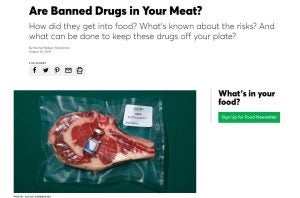Consumer Reports posted an article titled, “Are Banned Drugs in Your Meat: How did they get into food? What’s known about the risks? And what can be done to keep these drugs off your plate?,” sparking an outcry from the agriculture industry.
The National Cattleman’s Beef Association responded immediately, calling the article “sensationalist journalism” and stating the article had drawn “false and misleading conclusions meant to deceive consumers and reduce the consumption of meat.”
The Food Safety Inspection Service (FSIS) Acting Deputy Under Secretary Carmen Rottenberg issued a statement admitting that the unconfirmed data was released mistakenly, and the effort was made to correct the information. Rottenberg went on to call the story “sensational and fear-based infotainment aimed at confusing shoppers with pseudo science and scare tactics.” In her statement, she points out that Consumer Reports admits, in the final paragraph of the article, its intent to motivate people to consume less meat.
“Consumer Reports got the science 100 percent wrong on this one,” Rottenberg said. “We need to make sure we are dispelling any misinformation related to that article.”

The Sanderson Lawsuit, referenced in the CR article, was brought against poultry producer Sanderson Farms, although the online article is accompanied by a photo of a beef steak with a drug vial. The data released through a Freedom of Information Act (FOIA) request was in connection with the lawsuit and, Rottenberg said, the complaint was amended to remove all reference to the USDA FSIS residue testing data on June 25, prior to the August 28 publication of the article. A credit to the agency’s dedication to transparency, FSIS Chief Scientist Emilio Esteban, Ph.D, was deposed in the lawsuit even though the FSIS was not named. During his deposition, Esteban explained that the final results of the testing of the Sanderson chicken were negative for drug residue.
“They have amended their complaint to remove all reference to USDA FSIS residue testing results because they are inaccurate,” she said. “It’s not difficult to get that these are unconfirmed results and Consumer Reports chose to ignore the science.”
Process review
Rottenberg said she remains committed to being as transparent as possible in sharing data with consumers and industry as interest increases not only in the data but how it is analyzed and utilized. To that end, the processes in place to ensure that data released is the final result are being reviewed.
“We’re not looking to take any steps back from transparency, but I think we gain credibility when we come out in front of something and correct the mistake,” she said.
The residue-testing program is only one piece of the job at hand to keep America’s food supply safe. With over 9,000 professionals, the FSIS has a comprehensive hazard analysis and critical control point system.
“It’s incumbent on the industry to produce safe and wholesome product and our inspectors and lab personnel are there to verify that the industry has produced that product,” she said. “The industry is producing safe product every day.”
The idea that industry is colluding with the federal government and federal health partners to place unsafe food in the marketplace, Rottenberg said is patently false. She said industry, when faced with potentially damaging articles like CR’s, can point to the fact that farmers and ranchers produce a safe and wholesome product because it is their brand at stake.
“There are government controls in place to verify that and if there are ever any banned or violative substance found in a product, that product can not go into commerce,” she said. “Constantly saying that is better than saying nothing.”

Rottenberg said she often tells producer groups that if industry and government fail to come out and talk about the safety of the product, the processes to verify, and the number of people consuming it and depending upon it to be so, groups who do not consume the product are being allowed to fill a vacuum that occurs when no communication is present to fill the space.
“The more we talk about the safety of these products and the fact that we do have carcass by carcass inspection, and a robust program in this country with multiple federal public health partners, the more we fill the space with the food safety narrative and not the scare tactic narrative,” she said.
John Robinson, the Vice President of Membership and Communications for NCBA, said the author of the article, Rachel Rabkin Peachman, initially reached out to the NCBA and other commodity groups, inquiring whether or not they are notified when test results indicate the presence of violative drug residues. The answer, Robinson said, is that the USDA’s FSIS, a government entity, does not report to trade organizations like the NCBA.
Relied on unconfirmed data
Despite the original line of questions that Robinson and others representing various segments of the industry addressed for the author, the direction of the article centered upon unconfirmed test data, information erroneously released by the FSIS following the receipt of a Freedom of Information Act request. The FSIS worked to correct the error, providing accurate data from confirmed tests, but the author continued to utilize the inaccurate information.
“We did our very best to make sure (the author) had accurate information and our point of view,” he said. “Pork, poultry, dairy, and egg did the same thing. She engaged a number of commodity groups.”
The groups had the opportunity to cooperate prior to responding individually and Robinson said, attempted to answer with transparency and accuracy, knowing the inaccurate information from FSIS was released and likely to become skewed. Robinson commended the FSIS for attempting to be transparent even though a mistake was made.
“We, and I believe this extends to all of the commodity groups, believe in transparency, and we believe in an honest dialogue when it comes to questions about our industry,” he said. “We really do want consumers to understand that the food system here in the United States is safe, it’s the best in the world, the gold standard.”
Robinson said the main concern he has with this article and others like it, is intent.
“Clearly they took information that FSIS released and twisted it into something that it actually never was,” he said. “When that happens, it creates doubt in the mind of consumers.”
It’s the fast correction of misinformation that he said is important when faced with a circumstance like this one. Robinson applauded the FSIS for taking a public stance to, he said, set the record straight and stand up for the industry.
“It’s discouraging to see an organization like Consumer Reports take an agenda and turn factual data into something it’s not,” he said. “They had every opportunity to take another course and they chose not to.”



